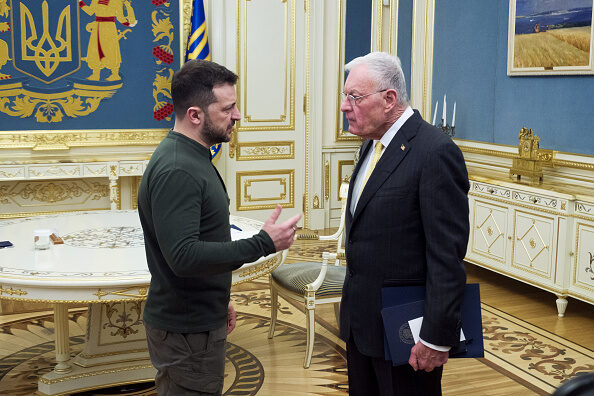US Special Envoy for Ukraine Keith Kellogg, though not a central figure in American efforts to end the war with Russia, has nonetheless made a new proposal with the intention of jumpstarting stalled peace negotiations: partitioning Ukraine “almost like Berlin after World War Two”.
Kellogg later clarified that his blueprint would split the country into three “zones of responsibility” rather than separate states, but the plan will still be a non-starter for both Kyiv and Moscow. Far from advancing peace talks, this proposal is more likely to derail them, driving both Russia and Ukraine away from a bargaining process that seems increasingly likely to give them a bad deal.
As he explained it to The Times, Kellogg’s plan sounds simple enough. After a ceasefire, Ukraine would be divided into an eastern region controlled by Moscow, comprising the territory Russia currently occupies; a middle region secured by Ukraine alone, stretching from the edge of the Russian zone to the Dnipro River; and a region west of the Dnipro, protected jointly by Ukraine and a reassurance force made up of British and French soldiers.
Though Kyiv might appreciate Kellogg’s inclusion of a European reassurance force, it will find the plan’s other conditions unacceptable. First, partitioning or dividing Ukraine into official zones of responsibility would explicitly recognise Russian jurisdiction over the Ukrainian territory it currently occupies. Although Ukrainian President Volodymyr Zelensky has signalled a willingness to accept Moscow’s temporary control of this land, Kellogg’s proposal goes further, offering the Kremlin what amounts to formal US acceptance of potentially permanent Russian dominion over the region. This crosses a key red line for Ukraine.
What’s more, Kyiv will push back against a deal that keeps European forces west of the Dnipro River. Zelensky wants British and French soldiers operating closer to the front line alongside his own army, where they can bolster deterrence — or serve as a tripwire which guarantees European support should Russia invade again. Any settlement that leaves Ukrainian soldiers alone along the line of contact will be met with bitter disappointment in Kyiv.
As much as Kyiv will dislike Kellogg’s partition plan, Moscow may hate it more. The proposal would put British and French forces inside Ukraine, spread across more than half the country — including right next to Russian-occupied territory in the southeastern corner — and might speed the integration of Ukraine’s western zone with Europe. Still, Kellogg has asserted that having European forces in this western region would “not be provocative at all” to Moscow.
Russia, having fought a three-year war to avoid just this outcome, will beg to differ. Foreign Minister Sergei Lavrov has made the Russian position clear, noting that Moscow will not accept the presence of soldiers from Nato countries in Ukraine “under any circumstances”. With his position on the battlefield improving, Russian President Vladimir Putin has little incentive to give Kellogg’s suggestions a second look.
But even if Ukraine and Russia could be talked into backing Kellogg’s proposal, the idea should still be rapidly dismissed. Where partition has been used to settle conflicts in the past, it has rarely set the foundation for a lasting peace. Instead, dividing a country into pieces more often leads to continued or new instabilities, as well as political and economic fissures along what are usually artificial dividing lines. In Ukraine, a partition — even into zones of responsibility as Kellogg proposed — would not resolve the war’s underlying drivers, address Russia’s or Ukraine’s remaining insecurities, or end the ongoing territorial disputes. Fighting might stop temporarily, but it would likely resume — this time with a greater risk of dragging Europe directly into the war.
Notably, the Trump administration has yet to comment on Kellogg’s plan, so it is unclear whether the proposal has wider support within the US government. Either way, it does not deserve serious consideration by American officials leading negotiations. Frustrations are rising as the war drags on but a partition of Ukraine, in any form, will not bring peace closer.











Join the discussion
Join like minded readers that support our journalism by becoming a paid subscriber
To join the discussion in the comments, become a paid subscriber.
Join like minded readers that support our journalism, read unlimited articles and enjoy other subscriber-only benefits.
Subscribe